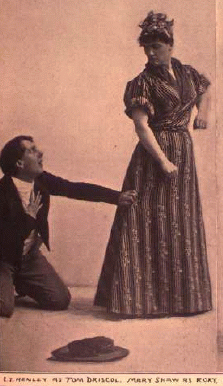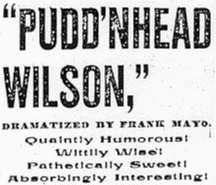Mayo's Adaptations

While several reviewers suggest Mayo erred in attempting to follow Mark Twain's story too closely, it's clear from comments scattered among the reviews that he made many changes in the plot of Pudd'nhead Wilson. Apparently to increase the occasions for humor, for example, he gave the character of Sheriff Blake a lot more stage business. Since, as the announcement in The New York Times put it, "the novel lacks a love story, without which no drama is complete, Mr. Mayo has supplied this deficiency by introducing a sentimental element." For the sake of this element, apparently, Wilson is given a sister (Patsy) and a niece (Rowy).
One intriguing suggestion in the reviews is that the romance subplot involves Rowy with "Chambers," even while he is presumed to be "black" and a "slave." It is clear that Mayo enlarged Chambers' role, and that the character was played sentimentally; presumably his love for Rowy remains undeclared until he and the rest learn that he is "white" and "free." In one respect the dramatization deals less euphemistically with the issue of miscegenation, for Mayo makes Tom and Chambers half-brothers, children of the same father: York Driscoll. That several reviews explicitly refer to the play as "decent" and "wholesome," however, suggests that there is very little direct discussion of the circumstances of Tom's conception and birth.
A major change, though treated by the reviewers who mention it simply as a variation on MT's story, concerns the switching of the babies. That is the focus of the play's prologue. Roxy accidentally sends the wrong infant to the christening of York Driscoll's "rightful white son"; the switch becomes her mistake. Thus Mayo eliminates any suggestion of Roxy's determination to save her son from slavery, or to enact her own rebellion against the system. The other consequence must have been to make her look like an awfully careless mother.
The first act begins with Dawson's Landing already anxious about the robberies. Pudd'nhead has seen a "black" girl climbing into Tom's window, thus identifying the thefts with slaves. Suspicion apparently first falls on Roxy, then on Chambers, until Pudd'nhead reveals the true culprit in the courtroom. The trial scene takes up Act Four. It follows the duel, and the wounding (rather than the killing) of Driscoll. As in the novel, Luigi is accused, and so becomes Pudd'nhead's first client in 23 years of waiting for one.

The play struck most reviewers as Pudd'nhead's story, perhaps because of Mayo's stature as an actor. While all agreed that the most powerful thing in the play was the trial scene, there was almost as much approval for the end of Act Three, where Pudd'nhead (unaware as yet of the switched babies) is shaken by apparent refutation of his belief in fingerprints. That by the very end he winds up vindicated and triumphant was, for most, the point of the story: while virtue is often unrecognized, it will eventually be rewarded.
Treating the play as essentially humorous, with strong elements of pathos and melodrama, and as a good account (complete with accents and costumes) of the Old South, reviewers gave little sign that the play was a serious confrontation with either slavery or race. It troubled one reviewer that Roxy was "white" but acted "black," but most admired the expressiveness with which her character was portrayed. Tom was invariably discussed as "a very bad villain"; several reviewers directly connected his evilness to his racial heritage. Apparently the theatrical business of the trial, with Pudd'nhead's exposure of Tom as the thief, the assailant, and a "black" slave, included a good deal of comedy. Two reviewers, at least, objected to two different comic bits as inappropriate in that situation. In general, however, the trial scene was seen as a thrilling conclusion to the gently but satisfyingly humorous "fun."
